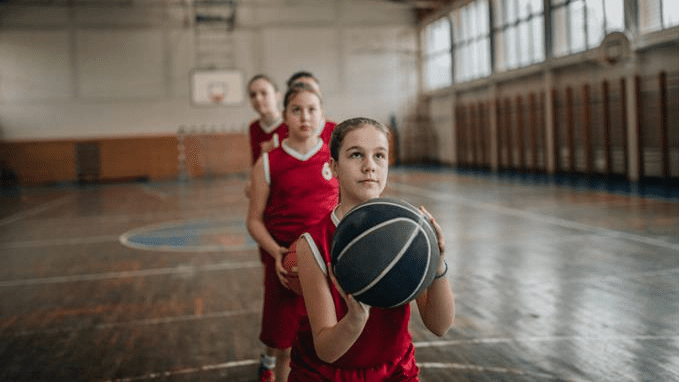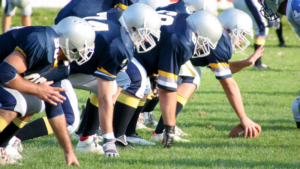That’s not to say that free throws don’t have pressure; very often, free throws can have more pressure than any other shot in the game because the shooter has time to think which is not normally a good thing. During a free throw shot, the focus of the entire gym is on the shooter and in late game situations the make (or miss) can mean victory or defeat and quickly moves from a team event to an individual effort.
Shooting a free throw has many of the same mechanics as a jump shot, but also has its own differences:
Jump Shot
- Base is approximate, while the feet are not always in exact same position
- Balance is approximate and practiced in different movements (straight, fade, left/right, lean, etc.)
- Target may be instinctual as vision may be blocked of obscured
- In rhythm, possibly in motion or in movement
- Visualization is real-time and game speed
Free Throw
- Base is exact and the feet are precise — will always be the same
- Balance is exact and precise — will always be the same
- Target is visible and exact
- In rhythm, but perfectly repeatable
- Visualization is slow and deliberate
You can see how precise each shot can tend to be in mechanics, but both differing in approach. Shooting percentage for free-throws should, logically, be much higher than FG percentage and good teams (and good shooters) prove this out time over time.
Free throws are a completely controllable situation if you practice effectively, which takes great focus. Below is a drill to practice free throw shooting:
- Start with the base; get into a good stationary shooting stance – feet shoulder width apart, heels slightly off the ground and knees bent slightly (no more than 45 degrees) with your back straight. Your dominate foot should be slightly ahead of your other.
- From this position you can use practical visualization. As everyone is setting up and before the official is ready to give you the ball, visualize a positive outcome in your mind (perspective from behind the ball) and practice the shot with form (think air-guitar, but this would be air shooting). If you are practicing and do not have a partner, do this with a chair beside you and place the ball in the chair until you have completed this step.
- Receive the ball from the official and breathe. Mentally visualize one more time and begin a shooting routine, I recommend keeping it simple and this is what I have my players do: Take three deliberate dribbles from a low position (knees bent). After the third dribble, find the air hole and, with seams horizontal, place middle finger directly under the air hole and splay fingers in normal shooting position.
- Slowly bring the ball up into a shooting position and pause. The shooting position is just above the eye but in a position that does not obstruct your view.
- At this point several things should be in place: Your shooting elbow should be in a near straight line above your knee and pointing toward your target. The bottom of your arm (your triceps) should be parallel to the ground. Your wrist should be bent back allowing your arm to be in a 90 degree position
- Look at your target. You should aim for the ‘turret’ that is furthest away from them, in this case it is the one that is dead center and closest to the backboard (the ‘turret’ is the part of the rim that holds the net; there are several of them and I believe you hit what you aim at, so if you hit the turret, which is inside the rim, you cannot miss).
- Use your legs and proceed to shoot, finishing on your toes with your shooting hand splayed toward your target. Hold this follow through until the ball touches rim or net.
- Follow your shot – be prepared to be hit as a defender should have responsibility for taking the shooter.
- On every shot, use positive keys words for immediate mental feedback – say these words out loud. On the make, say “YES!” (every make should be a positive experience). If you are short (ball hits the front of the rim or misses short entirely), say “Legs”. All power for shots comes from the legs and this is a reminder to use more legs to get a longer shot. If you are long (ball hits the back of the rim or further) say “Arch”. This is a reminder that if the ball had more arch, the shot would have had a better chance to become a make versus a miss. If you miss to the right, say “Left”, if you miss to the left, say “Right”.
An additional drill for free throws are below – if you are by yourself, shoot 50-100 and keep track of the makes so that you can compete against yourself later. When I shoot by myself, I shoot in segments of 10 and pick a player to represent each set and put an imaginary leader board in my head – anything to foster competition.
Team Pressure Free Throws
We use this drill to mix it up a little bit. You need at least 6 baskets, evenly distribute players at each basket and let them warm-up with 1-and-1s for a few minutes before you start the drill.
- Put a set amount of time on the clock – to begin the season, I start with 8 minutes but this changes when the team beats the game
- Refer to the illustration to keep track of this action. Starting at basket A, the clock starts and the first player shoots a free throw. Make or miss, the next shot is from basket B.
- If basket A makes the shot, that player will retain the ball and the score is 1, if not, the score is zero and the next shooter is up when basket A shoots again.
- Basket B is now shooting, once the shot is complete the next shot is from basket C.
- If basket B made the shot, the score is incremented by 1 and that shooter retains the ball. If the shot was a miss, the score is zero and the next shooter is up
- This continues, rotating baskets A – F, until either 6 shots are made in a row or the clock expires.
- If the clock expires and the goal of 6 is not met, the team has to run a sideline, a ladder, wall touches – get creative. If the goal is hit, the new target for the next time this is run is the completion time. For example, if 8 minutes were on the clock but the goal was met at 5:35, the next time the start time will be 5:35. Once you get to two minutes, the new goal is to set a record but the clock will always be at 2:00 to start.
How useful was this post?
Click on a star to rate it!
Average rating 1 / 5. Vote count: 1
No votes so far! Be the first to rate this post.



